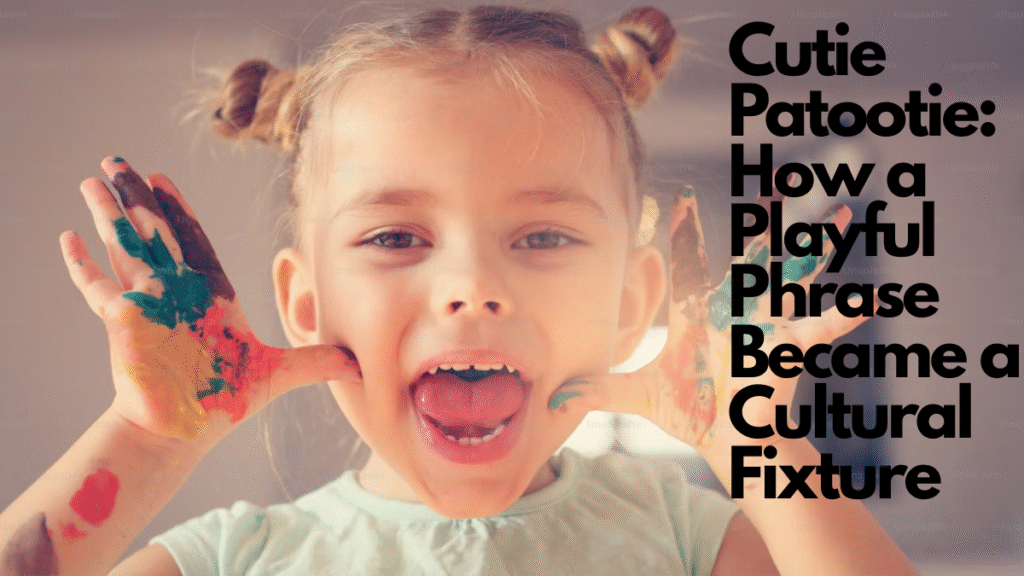Within the first few seconds of encountering the phrase cutie patootie, most people understand its intent: it’s an affectionate, whimsical way to call someone adorable. The words roll off the tongue like a nursery rhyme, designed more to delight than to impress. But what exactly does “cutie patootie” mean? Where did it come from? And why has this phrase endured across decades of shifting slang and social trends?
At its heart, cutie patootie is shorthand for endearment — a way of calling someone irresistibly cute. Unlike more formal or serious terms of affection, it operates in a playful register, often reserved for children, partners, or even pets. Yet, beneath its surface silliness, the phrase offers a fascinating glimpse into how language evolves, how words shape relationships, and why society gravitates toward linguistic play.
This article explores the phrase’s origins, meanings, uses, cultural appearances, and psychological implications. Along the way, we’ll examine how “cutie patootie” bridges generations and why it continues to surface in memes, pop culture, and casual conversation in 2025.
What Does “Cutie Patootie” Mean?
“Cutie patootie” is an informal phrase used to describe someone as adorable, charming, or irresistibly sweet. Unlike “beautiful” or “handsome,” which carry more formal tones, this expression conveys affection in a lighthearted, often humorous way.
In context:
- A parent might say to their child, “Come here, my little cutie patootie.”
- A friend might jokingly call a dog in a sweater “such a cutie patootie.”
- Online, it often appears in captions, memes, or playful banter.
The phrase has no strict grammatical rule; it’s used more for emotional effect than for precision. Its value lies in the joy it delivers and the warmth it conveys.
The Origins of the Phrase
Tracing slang is never simple, but the rise of “cutie patootie” can be linked to the mid-20th century in the United States. “Cutie” had already been popularized as early as the 1910s, appearing in newspapers and films to describe someone attractive or lovable. The suffix “patootie” likely emerged as playful rhyming slang.
The term gained mainstream traction in the late 1990s and early 2000s, thanks in part to daytime television. Actress Rosie O’Donnell frequently used “cutie patootie” on The Rosie O’Donnell Show, referring to child guests with the phrase. Her show’s popularity helped plant it in the cultural lexicon, where it quickly stuck.
Why People Use “Cutie Patootie”
Language is more than words; it’s a tool for emotion. So why do people reach for a phrase as silly as “cutie patootie”?
Emotional Softening
“Cutie patootie” makes affection less intense and more approachable. Saying “you look beautiful” can sometimes feel too formal, but “you’re a cutie patootie” lands with warmth and playfulness.
Universality
Its childlike rhythm makes it suitable across relationships — from parents and children to couples, friends, and even strangers online.
Memorability
Rhyme and rhythm matter. Humans are wired to remember patterns, and the playful rhyme of “cutie patootie’s” makes it stick in memory.
A Table of “Cutie Patootie” in Context
| Context | Example Usage | Tone | Audience |
|---|---|---|---|
| Parenting | “Bedtime, my little cutie patootie.” | Affectionate | Children |
| Romance | “You’re my cutie patootie forever.” | Playful, loving | Partner |
| Friendship | “Look at you, cutie patootie!” | Lighthearted | Friends |
| Pets | “That cat is such a cutie patootie.” | Warm, humorous | Pets/animals |
| Online | “Selfie goals, cutie patootie’s.” | Casual, trendy | Social media |
Cutie Patootie and Pop Culture
The phrase is not just confined to households; it has repeatedly surfaced in pop culture.
- Television: Rosie O’Donnell’s use remains the most famous, but sitcoms occasionally dropped the phrase to signal comic exaggeration.
- Music: Some pop songs sprinkled the phrase into lyrics during the late 90s, cementing its playful tone.
- Memes: By the 2010s, “cutie patootie’s” evolved into meme captions, particularly attached to animal photos and baby videos.
In 2025, the phrase is experiencing a minor renaissance on platforms like TikTok, where creators revive nostalgic slang to give their content a retro twist.
The Psychology of “Cutie Patootie”
Why do people find such words appealing? The answer lies partly in cognitive psychology.
- Phonetic Softness: Words with repeated vowels and rhymes create a sense of comfort. Just as lullabies soothe children, rhyming slang reassures adults.
- Nostalgia Effect: Many people first heard “cutie patootie’s” in childhood, linking the phrase to safety and affection.
- Play as Bonding: Playful language strengthens bonds. By using humor and silliness, people signal intimacy without vulnerability.
Regional and Generational Differences
Interestingly, not everyone uses “cutie patootie’s the same way.
- United States: Most common, with widespread recognition.
- United Kingdom: Less popular, though some playful equivalents exist (“cheeky monkey” or “sweetie pie”).
- Generational divide: Millennials often associate the phrase with 90s television, while Gen Z may use it ironically online.
The Phrase in Digital Life
The internet has extended the lifespan of “cutie patootie’s” far beyond its TV roots. Online, the phrase often attaches itself to animals — cats in costumes, dogs making funny faces, or babies doing adorable things.
Hashtags like #CutiePatootie still generate traction. The phrase thrives in environments where visual cuteness meets verbal play.
Why “Cutie Patootie” Endures
Slang comes and goes, but a handful of phrases last decades. “Cutie patootie” endures for three reasons:
- It fills a linguistic gap. There are few phrases that combine affection, humor, and cuteness so effectively.
- It adapts easily. Whether spoken in earnest or irony, it works.
- It brings joy. In a digital era often crowded with sarcasm, “cutie patootie’s” remains refreshingly wholesome.
Variations and Cousins of the Phrase
Other phrases share a similar structure or tone:
- “Sweetie pie”
- “Honey bunny”
- “Lovey dovey”
- “Snuggle bug”
Each follows the pattern of rhyme, rhythm, and repetition — the linguistic recipe that makes “cutiepatootie” memorable.
How to Use It Without Overdoing It
While charming, the phrase can become cloying if overused. Context matters:
- Personal Settings: Works best among friends, partners, or family.
- Professional Settings: Avoid in formal workplaces, where it may seem unserious.
- Online: Safe to use in memes, captions, or playful comments.
Looking Ahead: The Future of “Cutie Patootie”
In 2025, nostalgia drives much of internet humor. As people revive Y2K aesthetics and 90s slang, “cutie patootie’s” is part of that cycle. Its future likely rests in digital communities, where phrases can be preserved indefinitely.
It may never return to peak daytime TV fame, but in memes, pet videos, and affectionate exchanges, “cutie patootie’s” is here to stay.
FAQs
1. What does “cutie patootie” mean?
It means someone or something is extremely cute, adorable, or lovable in a playful, affectionate way.
2. Where did “cutie patootie’s” originate?
It became popular in the 1990s, particularly through Rosie O’Donnell’s daytime television show, though “cutie” existed earlier.
3. Is “cutie patootie’s” used seriously or as a joke?
Both. Some use it sincerely with children or partners, while others use it ironically in memes or banter.
4. Is “cutie patootie’s” outdated?
Not entirely. While less common in everyday conversation, it thrives in nostalgic and digital contexts.
5. Can “cutie patootie’s” be used internationally?
Yes, though it’s most recognized in the United States. Other cultures may use similar rhyming phrases instead.







